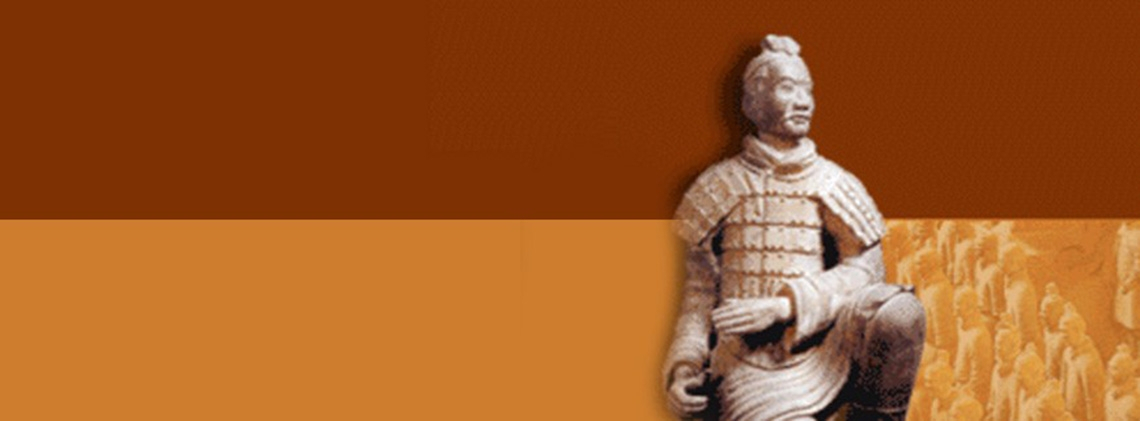
Mausoleum of the First Emperor of Qin and the Terracotta Warriors
Splendid
Chi Culture
Topic
Mausoleum of the First Emperor of Qin and the Terracotta Warriors
One of the most spectacular sites in the world, the Mausoleum of the First Emperor of Qin (259–210 BCE), was constructed over a span of thirty-eight years by 720,000 people. The terracotta warriors are a collection of sculptures buried with the emperor, depicting his powerful army. Together, they are known as the “Eighth Wonder of the World.” In 1987, the mausoleum, including the terracotta warriors, was inscribed on the List of World Heritage Sites by the United Nations Educational, Scientific and Cultural Organization.
The Mausoleum of the First Emperor of Qin is located at the northern foot of Mount Li near Xi’an in Shaanxi province. The mausoleum is rectangular; its longer edge runs north-south and the shorter edge, east-west. The surface structures would have included the tall tomb mound, magnificent palaces, and strong walls as well as a dam on the south side of the mausoleum. Unfortunately, they were all destroyed not long after the First Emperor’s (259–210 BCE) death.
Inside the mausoleum, the most mysterious place would have been the underground palace. According to Sima Qian’s (ca. 145–ca. 90 BCE) Shi ji (Records of the historian), the First Emperor ordered prisoners to dig until they reached the water table. Then, they poured in molten bronze to block the mouth of the spring and placed the coffin there. Replicas of court palaces, halls, and seating arrangements for officials were constructed inside the tomb. Rare and precious items would also have been stored there. Fearful of looters, the First Emperor ordered workers to make hidden mechanisms capable of shooting arrows. On the ground, mercury was used to simulate the waterways and the sea, while on the ceiling workmen made likeness of the heavens. The lamps were kept lit with the oil of the giant salamander (Andrias davidianus) which was thought to burn for a very long time.
The mausoleum also includes subordinate pits of varied sizes. Hundreds of pits and graves have been discovered, so far. The pits containing the terracotta warriors are the largest and their excavation astonished the world but the discovery of a pit with bronze carriages and horses caused a sensation as well. More than ten thousand artifacts have been found in the pits and subordinate graves. They are valuable materials for the study of the history of the mausoleum and the Qin dynasty (221–206 BCE).
The terracotta warriors were discovered in pits during the 1970s. Based on these pits, archaeologists can deduce the construction methods: first, a vault about five meters deep was dug, and its earthen walls were hardened by ramming. Several partitions were built in the vault to form passageways; and, around the pits and partitions, wood pillars were placed every 1.4 meters. The bottoms of the pillars were connected with rectangular wooden grade beams. At the tops of the pillars, the rafter-plate supported the intersecting beams comprising the wood frame. The frames and partitions were covered by narrow wooden strips; on the wooden strips were placed mats and earth to form the ceiling of the vault, two meters from the ground. The bottom of the vault was paved with grey bricks. The inner space measures about 3.2 to 3.8 meters high. When the terracotta warriors and horses were placed in the pits, each of the four exits was blocked by upright timbers in order to seal off the underground space.
The arts of painting and sculpture were joined in the terracotta warriors. Noteworthy aspects of them are: the emphasis on lifelikeness; the smartly designed composition and the agile technique; the integration of spirit and form makes the sculptures both realistic and decorative. The terracotta warriors were carved with meticulous care; among more than one thousand warriors and horses no two are alike. The craftsmen used different techniques including molding, piling, shaping by hand, pasting, carving, and drawing. The artisans made sure the figurines were lifelike in their form and size but also in their appearances, facial expressions, and accessories. Visitors who see them are struck by their seeming liveliness, and profundity, as well as by their extensiveness, and their grandness and delicacy.
The terracotta warriors are not only masterpieces of art, but are also extremely valuable cultural relics. They can help us achieve a deeper understanding of the Qin military system, its affairs, and equipment. Additionally, the terracotta warriors, to a limited extent, reflect the social custom of the Qin dynasty. The weapons discovered in the pits attest to the extremely high level of metallurgy that existed more than two thousand years ago.



